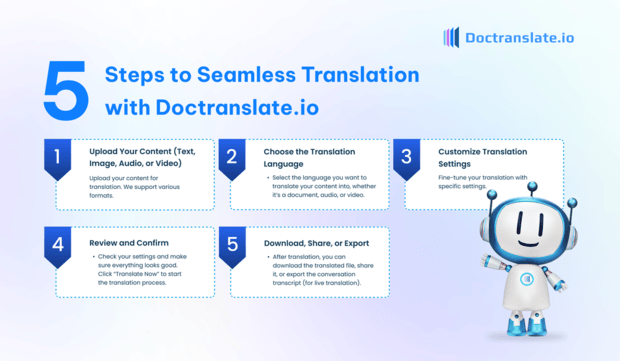Introduction
Breaking language barriers is crucial for global reach.
Translating content like software strings is a key part of this.
It ensures your software is accessible to users worldwide.
Especially when translating from languages like Simplified Chinese to English.
Manual translation can be slow and prone to errors.
Automated tools offer speed and efficiency.
However, accuracy is paramount for technical content.
This is where reliable platforms become essential.
DocTranslate.io provides a seamless solution.
It’s designed to handle various content types.
From documents and text to images, audio, and video.
Making translation easy and accurate for businesses and individuals.
This guide focuses on translating software strings.
Specifically, from Simplified Chinese into English.
We’ll walk you through the steps using the platform’s features.
Get ready to make your software multilingual efficiently.
Step-by-Step Guide: Translating Software Strings from Simplified Chinese to English with DocTranslate.io
Step 1: Upload Your Content File
The first step is getting your software strings into the platform.
Often, these strings are contained within specific file formats.
These could be documents or text files.
**DocTranslate.io Document Translation** supports many types.
You can upload files like DOCX, PDF, and TXT.
It also supports spreadsheets such as XLSX and CSV.
Even presentation files like PPTX are compatible.
This flexibility covers most needs for software string files.
Navigate to the document translation section on the site.
Simply drag and drop your file into the upload area.
Alternatively, you can click to browse and select your file.
Ensure your file format is supported for a smooth start.
For smaller text snippets not in a file, use **DocTranslate.io Text Translation**.
You can paste up to 5000 words directly.
This is useful for quick translations of single strings.
Choose the method that best fits your content’s format.
Step 2: Choose the Translation Language
Once your file is uploaded, you need to specify the languages.
Select ‘Simplified Chinese’ as the source language.
This tells the system what language your strings are currently in.
Accuracy depends on setting the correct source language.
Next, choose ‘English’ as the target language.
This is the language you want your software strings translated into.
**DocTranslate.io** supports a vast number of languages.
Making it easy to translate between many language pairs.
Double-check your language selections before proceeding.
An incorrect setting will result in a faulty translation.
The platform’s interface makes this step straightforward.
Just select from the dropdown menus provided.
This step is critical for successful localization.
It ensures your English-speaking users understand your software.
Proper language pairing is a fundamental part of the process.
Confirm your choices and move to the next configuration step.
Step 3: Customize Your Translation Settings
Customization helps achieve a more accurate translation.
Especially for technical content like software strings.
**DocTranslate.io** offers several options here.
These settings help tailor the output to your needs.
Consider the tone of the translation.
For software strings, a ‘Serious’ or ‘Formal’ tone is often appropriate.
Avoid informal tones for user interface text.
The platform allows you to select the desired tone.
Using the ‘Domain’ feature can further improve accuracy.
Select a domain like ‘Technology’ or ‘Software’.
This helps the AI understand the context better.
Leading to more precise translations of technical terms.
The ‘My Dictionary’ feature is highly valuable.
You can add specific terminology used in your software.
Define how these terms should be translated.
This ensures consistency and correctness for unique terms.
Opting for ‘Bilingual translation’ is also helpful.
This generates a document with both source and target text.
It makes reviewing and comparing the translation easier.
For critical strings, a side-by-side view is very beneficial.
Step 4: Review and Confirm
Before starting the translation, review your settings.
Check the uploaded file name and type.
Confirm the source language is Simplified Chinese.
Verify the target language is set to English.
Look over the customization options you selected.
Ensure the tone, domain, and dictionary settings are correct.
This final check prevents potential errors.
A moment spent reviewing saves time later.
The platform typically shows a summary of your choices.
Take advantage of this summary screen.
Make any necessary adjustments at this stage.
It’s your last chance to configure the translation job.
Once you are satisfied with all the settings, click the ‘Translate Now’ button.
The system will begin processing your request.
The time taken depends on the file size and complexity.
Sit back and let **DocTranslate.io** do the work.
Step 5: Download, Share, or Export
After the translation process is complete, your translated file is ready.
You will be notified when the translation is finished.
The translated version will be available for download.
Download the file containing your English software strings.
Depending on the original file type, the output will be similar.
A translated DOCX stays a DOCX, a CSV stays a CSV.
This preserves the formatting and structure of your file.
Making it easy to integrate back into your software project.
For **Text Translation**, you can simply copy the translated text.
For other media types like audio or video, options differ.
Audio translations might provide a transcript.
Video translations often include translated subtitles.
You can also typically manage your past translations.
Access them from your account dashboard.
This allows you to revisit or re-download files.
**DocTranslate.io** keeps your history organized.

Conclusion
Translating software strings from Simplified Chinese to English is now straightforward.
Using **DocTranslate.io**, the process is efficient.
You can handle various file formats containing your strings.
Ensuring accurate translations for your software.
By following these simple steps, you leverage powerful AI technology.
Customize settings like tone, domain, and dictionary.
Achieve high-quality results tailored to your specific needs.
Making your software accessible to a wider, English-speaking audience.
**Document Translation** handles your files with ease.
**Text Translation** is perfect for quick string checks.
Explore other features like **Image Translation** for embedded text.
Or **Audio** and **Video Translation** for multimedia content.
Start translating your software strings today.
Expand your reach and connect with users globally.
**DocTranslate.io** is your partner in overcoming language barriers.
Experience seamless and accurate translation now.


Leave a Reply